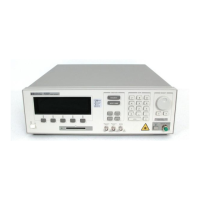D
Power Flatness over Wavelength
1. Set up the equipment as shown in Figure D-4 (HP 8167A, 8168D
,E,F).
2. Set the TLS
a. Set the power to:
#023 #003 #023+#003 #007
8167A -4dBm -5dBm -5.5dBm -6.5dBm -5dBm
8168D -4dBm n/a n/a n/a -5dBm
8168E 0dBm -1dBm -1.5dBm -2.5dBm -1dBm
8168F +1dBm 0dBm -0.5dBm -2.5dBm 0dBm
b. Set the wavelength to
HP 8167A 1280nm
HP 8168D 1500nm
HP 8168E 1500nm
HP 8168F 1475nm
3. Set the Power Meter
a. Select Auto Range.
b. Select averaging time 500ms.
c. Select display in dB.
d. Set the wavelength to
HP 8167A 1280nm
HP 8168D 1500nm
HP 8168E 1500nm
HP 8168F 1475nm
e. Set
4
DISP-
>
REF
5
4. Increase the wavelength on the TLS and on the Power Meter by the steps
listed in the test record. Measure the output power.
Note the result in the test record
5. repeat list item 4 for the wavelength settings given in the test record.
6. From the measurement results calculate the dierence between the
maximum and minimum deviation from REF and note the result as Flatness.
D-14 Performance Tests

